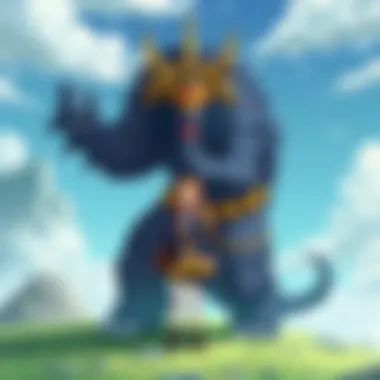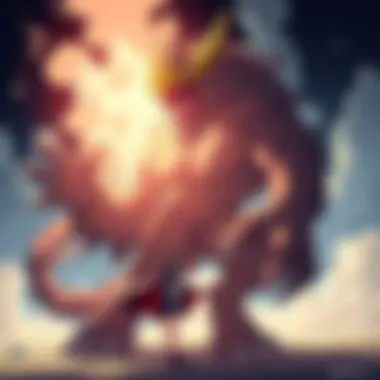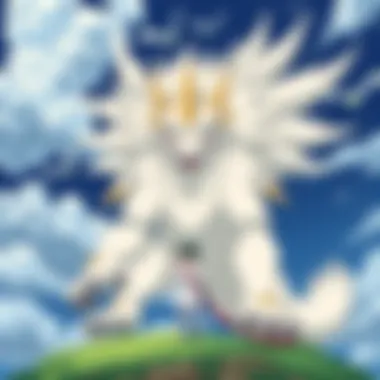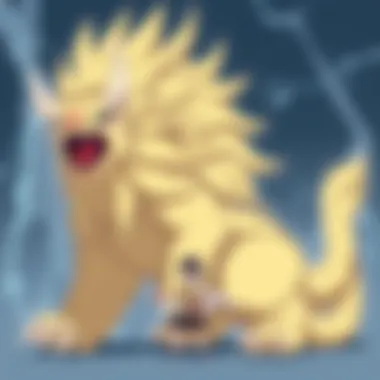The King Beast: An In-depth Look at Apex Creatures in Anime


Intro
The concept of the 'king beast' emerges as an essential element within the realms of anime and manga, capturing the imagination of creators and audiences alike. These apex creatures, often embodying a blend of raw power and intricate narrative depth, serve as pivotal figures that reflect broader human experiences and cultural narratives. In exploring this archetype, one might ask: what drives these characters to embody greatness and fear? Why do they capture the essence of transformation, struggle, and the very essence of humanity itself?
Drawing from a rich tapestry of series, including Attack on Titan, Naruto, and Fullmetal Alchemist, the 'king beast' trope ranges from monstrous adversaries to complex allies. It’s not just about the physical prowess or menacing presence of these characters; rather, it is their layered backstories and the thematic richness they contribute to their respective narratives that make them noteworthy.
In this article, we will dissect the 'king beast' archetype through various lenses, examining its significance in storytelling and character development. Moreover, we'll probe into the cultural implications that these characters embody and how they resonate with the audience. Expect a detailed look at notable instances, character arcs, and the thematic exploration of what it means to be the 'king beast' in the world of anime and manga.
Preamble to the King Beast Concept
The realm of anime and manga is teeming with fantastical creatures, yet few hold the gravitas of the so-called ‘king beast’. Understanding this archetype not only enriches one’s viewing experience, but it also unveils layers of storytelling that often go unnoticed. The king beast embodies the apex of power and complexity in narrative arcs, serving as both a symbolic representation and a catalyst for character transformation.
Defining the King Beast Archetype
To put it plainly, the king beast is more than just a large, imposing creature. It's a nuanced figure, often blending traits of both beast and royalty. Imagine Godzilla or a Dragon Ball Z’s Shenron—these are not merely monsters but representations of primal instincts, power, and hope. They command authority in their respective worlds, and their actions often set in motion critical events that shape the plot. The king beast often represents a dichotomy between beauty and beastliness, where its very existence invites both admiration and fear.
The archetype usually involves characteristics like:
- Immense power that instills awe.
- Duality within its nature—heroic yet at times a villain.
- Symbolic significance, representing not just raw power but societal themes like justice or chaos.
By defining this archetype, we open a window to the rich storytelling potential implicit in these creatures. Whether they stand as obstacles to overcome or allies to protect, king beasts push characters to their limits, prompting growth and introspection.
Historical Context in Literature and Folklore
The origins of king beasts can be traced back through the annals of mythology and folklore. In many cultures, these creatures symbolize deeper truths about human nature and society. Take, for instance, the Minotaur from Greek mythology; it stands as an embodiment of man’s inner beast, trapped within the labyrinth of its own mind. In Japanese folklore, the legendary kappa illustrates the complex relationship humans have with nature, reflecting both reverence and caution.
Observing ancient stories reveals a pattern:
- Cultural reclaims of nature, where beasts represent the untamed.
- Moral lessons and the consequences of overreaching, as seen in tales of Prometheus.
- The manifestation of fears and dreams, akin to modern interpretations in anime and manga.
These historical contexts enrich the narrative fabric of contemporary works, where the king beast archetype often embodies the struggles of humanity itself—between our aspirations for power and the consequences of our primal instincts. Thus, king beasts serve as vital narrative devices that echo themes as old as storytelling itself.
The Symbolism of King Beasts
The concept of the King Beast in anime and manga serves as a fascinating lens through which we can examine various themes and symbols in storytelling. This figure often embodies a complex interplay of power, authority, and transformation, making it a rich subject for analysis. Audience engagement often peaks when these beasts are involved, as they represent not just physical might but also the psychological struggles that characters face. Their presence can underscore moral dilemmas, enrich narratives, and provide a captivating spectacle.
Power and Authority in Narrative
King Beasts frequently exemplify supreme power within their respective narratives. They often rise above mere creatures; they become symbols of authority and control. In many series, a King Beast is either the ruler of a realm or a guardian possessing intimidating strength. For instance, in the anime "Naruto," the tailed beasts wield significant power, often influencing the story's political and social framework. The protagonists’ struggles against or alongside these beasts highlight the quest for dominance, be it over oneself or one's enemies.


- These characters often embody themes of conquest—both in the sense of an external battle and conflicts within.
- Their power often reflects the ambitions and fears of the characters surrounding them, showcasing an individual's growth or regression.
A striking moment occurs in "Attack on Titan," where the Beast Titan, Zeke Yeager, showcases his immense power, instigating a broader conflict that ultimately shapes the series' narrative trajectory. Such symbolic representations of authority provide depth to the story, making viewers ponder the nature of power itself and its implications on society.
Transformation: Physical and Psychological
Transformation is a recurring element in the arcs of King Beasts, emphasizing not only their physical changes but also psychological evolution. In many narratives, these creatures undergo significant metamorphosis, representing growth, decay, or change in perspective. This process often highlights the struggle between inner demons and desired identities.
Consider the example of the beastly transformations seen in the series "Fullmetal Alchemist," where the character Envy embodies the struggle with his identity and self-worth. The transformation from a seemingly invincible creature into a tragic figure compels viewers to reconsider the implications of their own transformations throughout life's trials.
- This duality of transformation—both visually and emotionally—offers a reflection of the inherent conflicts within humanity.
- Characters that interact with these beasts often find themselves changed, suggesting that encounters with such entities serve as catalysts for personal evolution.
Contrasting Humanity with Bestial Instincts
The existence of King Beasts within the narratives often invites exploration of the contrast between human traits and bestial instincts. At times, these creatures represent primal urges and deep-rooted fears that lie within humans. This dichotomy reveals the fragility of civilization, suggesting a thin veneer between humanity and savagery.
In the manga "Tokyo Ghoul," Ken Kaneki’s transformation into a ghoul acts as a stark portrayal of this theme. As Kaneki grapples with his new bestial instincts, the reader is confronted with questions about what it truly means to be human. This tension fosters moral ambiguity, challenging characters (and the audience) to examine their inherent natures and desires.
“The King Beasts remind us that within each of us resides both the beast and the human, and it is our choices that define who we are.”
Through these complex interactions, narratives often highlight society's struggles with primal instincts and cultivated behaviors. By depicting King Beasts in this way, authors encourage audiences to reflect on their values and the instincts that often fight for dominance within our minds.
Notable King Beasts in Anime and Manga
Delving into notable king beasts in anime and manga opens up a treasure trove of narrative depth and thematic richness. These apex creatures serve as more than mere characters in a story; they embody the very essence of power, authority, and elemental forces. By exploring these beasts, we not only gain insight into their individual arcs but also understand how they resonate with cultural motifs and symbolic representation. Each creature, drawn from the tapestry of folklore and mythology, is meticulously crafted with unique traits that speak to human experiences, forging connections between audiences and narratives.
Cerberus: The Guardian of the Underworld
Cerberus, the three-headed dog from Greek mythology, finds its way into various anime and manga adaptations, often as a guardian of the underworld. In series like "Fate/Stay Night", this ferocious beast is not just a loyal servant; it represents the threshold between life and death. Cerberus stands as a symbol of protection but also as a warning against crossing into realms unattainable for mortals. This duality illustrates a complex relationship between power and responsibility.
- Role in the Narrative: Cerberus often acts as a gatekeeper, controlling who may enter or leave the underworld. This positions him in stories where the protagonists must confront their fears or seek redemption.
- Character Traits: Fierce loyalty, immense strength, and an unyielding sense of duty characterize Cerberus, highlighting themes of sacrifice and guardianship.
- Cultural Significance: Often rooted in a deep respect for the dead and the afterlife, representations of Cerberus challenge audiences to reflect on mortality and the choices we make in life.
Dragon Characters: Mythical Kings of the Skies
Dragons are perhaps the most iconic king beasts depicted in anime and manga. They are often portrayed with regal majesty and formidable power. In series such as "Dragon Ball" and "Fairy Tail", these mythical creatures embody the ultimate forces of nature, commanding respect and awe.
- Diversity in Representation: Dragons can range from benevolent mentors to terrifying adversaries, showcasing the many facets of their nature. For instance, Shenron from "Dragon Ball" grants wishes, whereas Igneel from "Fairy Tail" represents the fierce protector.
- Symbolism of Control: Often associated with elemental forces like fire or storms, dragon characters symbolize mastery over the chaos of nature. Their story arcs often explore themes of destiny, freedom, and the burdens of power.
- Cultural Archetypes: The dragon as a king beast resonates deeply across cultures, including the Western dragon of destruction versus the Eastern dragons viewed as bearers of wisdom and good fortune.
The Beast of the Apocalypse: Symbolism and Roles
The "Beast of the Apocalypse" is a powerful representation in various narrative arcs, often depicting themes of destruction, rebirth, and the cyclical nature of existence. This archetype can be found in series such as "Attack on Titan" and "Berserk", where these creatures serve as manifestations of societal fears and existential dread.


- Role in Apocalypse Narratives: The beast often symbolizes the end of an era, forcing characters and societies to confront the consequences of their actions. This portrayal invites audiences to examine what leads to annihilation and the potential for renewal that lies beyond.
- Psychological Depth: These characters often serve as mirrors for the protagonists’ struggles, embodying their internal conflicts and representing the darker aspects of human nature.
- Important Questions Raised: The existence of such beasts prompts important consideration about morality, fate, and the repercussions of humanity’s choices.
"The king beast often acts as a lens through which we can explore our own existence and the forces that shape our lives."
By analyzing notable king beasts within anime and manga, we unravel a rich tapestry of storytelling that resonates with universal themes—power, mortality, and the quest for meaning in a chaotic world.
Cultural Impact of King Beasts
The concept of King Beasts stretches beyond mere character design or narrative trope in anime and manga. It taps into deep-rooted cultural beliefs and societal norms, reflecting human fears, aspirations, and complexities. They are often depicted as the amalgamation of power, clashing identities, and moral questioning, which can resonate with diverse audiences around the globe. The impact of King Beasts can be examined through various lenses, from their depiction across different cultures to their influence on modern storytelling techniques.
Regional Variations Across Cultures
Each culture carries its unique lore surrounding beasts, and this diversity influences how King Beasts are portrayed in anime and manga.
- Japanese Folklore: In Japan, creatures like Tengu and Yokai possess supernatural abilities that symbolize both wisdom and chaos. They serve as guardians or adversaries, mirroring the duality of man—both good and evil. The Tengu, specifically, has become a metaphor for a wise yet lonely figure, influential in works such as Naruto, where many characters grapple with their inner demons.
- Western Mythology: Comparatively, Western representations often lean towards dragons or griffins. These beings typically represent strength and a noble cause, like in Game of Thrones, where dragons are embodiments of power and destruction but also of hope and freedom. This stark contrast highlights how cultural narratives shape the perception of such creatures, affecting how audiences relate to them.
- African Legends: In African folklore, King Beasts like the Sokoto bird or the Mami Wata embody nature's wrath and bounty. These stories can often interweave themes of survival and community spirit, found in series that attempt to adapt such themes within a fictional realm.
Influence on Contemporary Storytelling
The portrayal of King Beasts has also transformed the fabric of contemporary storytelling in notable ways. Their roles extend beyond being mere backdrops; they are central to character development and thematic depth.
- Character Complexity: With stories evolving, many King Beasts are no longer characterized strictly as villains or allies. They embody conflict and growth, often transitioning from antagonistic to supportive figures, or vice versa. Rethinking traditional roles opens new avenues for narratives, as seen in Attack on Titan, where titans embody both threat and a tragic past, prompting viewers to reconsider their own definitions of morality.
- Exploration of Themes: Modern narratives infuse King Beasts with notions of strength juxtaposed with vulnerability, exploring themes like identity and existential dread. Series like Fullmetal Alchemist utilize homunculi as King Beasts to delve into the human condition, merging philosophical questions of life, purpose, and the consequences of one’s choices.
"The beauty of King Beasts in anime and manga is their duality. They often symbolize both parts of ourselves we fear and those we admire."
Their influence can’t be understated; it reshapes character arcs and drives plotlines, encouraging viewers to confront their own beliefs and societal issues. By understanding the diverse cultural implications and the evolution of their narrative roles, one can appreciate why King Beasts remain a powerful symbol in anime and manga.
In essence, King Beasts enrich stories and invigorate cultural dialogues, allowing audiences to engage with their depths on a more profound level.
Analyzing Character Arcs of King Beasts
As we explore the realm of king beasts, one pivotal angle that emerges is the analysis of their character arcs. These arcs not only shape the individual narratives within anime and manga but also serve as a microcosm of major themes like power, identity, and morality. Characters that embody the king beast archetype often experience profound transformations throughout their stories, reflecting deep-seated emotional and psychological struggles. Within this section, we will dissect the nuances of these character journeys, highlighting notable examples and their implications within the broader cultural context.
From Antagonist to Protagonist: A Shift in Perspective
One of the most compelling aspects of king beasts in storytelling is their capacity for transformation from antagonist to protagonist. This shift challenges audiences to reevaluate their perceptions of good and evil, often resulting in rich narrative layers. Characters like Inuyasha from "Inuyasha" exemplify this evolution. Initially introduced as a brooding half-demon with a fierce temper and questionable morals, Inuyasha's arc leads him towards a more heroic role. This trajectory not only enhances the drama but also invites viewers to empathize with his struggles between beastly instincts and human emotions.
In a broader sense, the shift from villain to hero can prompt viewers to question the nature of evil. Are these beasts inherently malevolent, or do their circumstances shape their actions? This exploration fuels debates surrounding morality and character development in art. It serves as an essential lens through which audiences can dissect motivations and conflicts, making the king beast archetype an effective tool for rich storytelling.
Redemption Arcs and Moral Complexity
Redemption arcs play an integral role in character development. For king beasts, the disparity between their primal nature and the search for understanding introduces layers of moral complexity. A striking example here would be the character Zeke from the anime "Attack on Titan," who, despite his beastly title, grapples with themes of heritage, expectation, and identity.


In stories featuring king beasts, redemption doesn’t come easily. Characters often undergo significant pain or suffering before a shift in values occurs. This aligns with the audience’s expectations of witnessing grit and turmoil before achieving self-acceptance or growth. This complexity paves the way for a valuable discourse around themes such as atonement and the potential for change, posing significant questions about the nature of one's choices versus their inherent instincts.
In the end, through thorough analysis of these arcs, we discover that king beasts serve as both mirrors and catalysts for human nature. Their journeys compel us to confront our complexities, extending beyond mere narrative devices to become conduits of significant thematic exploration. By observing their transformations, we gain insight into our morality, identity, and the intricate balance between our bestial instincts and the human experience.
“King beasts illustrate that the path to redemption is often rife with challenges and nuances, reflecting our own journeys of growth.”
Understanding these character arcs allows audiences to engage with anime and manga on a deeper level, discovering meaning that transcends the surface excitement of supernatural battles and epic transformations.
Thematic Explorations
The theme of king beasts occupies a significant space in anime and manga, serving as a mirror to various aspects of human existence. When we delve into the narratives woven around these apex creatures, we uncover layers of complexity that reflect societal values, personal struggles, and existential questions. The relevance of this theme stems from its ability to resonate with audiences on a profound level, as it embodies struggles, aspirations, and the conflict between civilization and primal instincts. By scrutinizing these thematic elements, we gain a richer understanding of both the characters themselves and the overarching messages conveyed in these stories.
Existential Questions Raised by King Beasts
In many narratives, king beasts epitomize the struggle with identity and purpose. Characters such as Inuyasha or Guts from Berserk present an ongoing battle that challenges their very nature as they grapple with the beast within. This brings forth existential questions that resonate with the audience: What does it mean to be truly human? Are we defined by our instincts or our choices?
The duality of the king beast often acts as a vehicle for exploring such questions. On one hand, they represent raw, untamed power and instincts that can lead to destruction. On the other, they illustrate a journey toward self-awareness, where strength becomes a metaphor for moral choices. This tension creates a compelling narrative arc that allows viewers to reflect on their own identities as they navigate the complex terrain of their lives. For instance, the contradictory nature of Mebius in Soul Eater showcases the fine line between becoming a protector and a fearsome menace, making the audience ponder where the line lies for their own choices.
"The king beast in narrative often mirrors the subconscious struggles of the human psyche, sparking curiosity on the nature of self and morality."
Nature vs. Nurture: Implications in Character Development
In the realm of anime and manga, the debate of nature versus nurture frequently emerges within the context of king beasts. Characters shaped by experiences and reactions to their environment challenge the notion that traits are solely inherited. Instead, many key figures embody the belief that one’s environment and choices ultimately define their trajectory.
Take Kurama from Yu Yu Hakusho; his journey from a fierce demon to a protective spirit highlights how external influence transforms characters. In instances like this, it becomes evident that characters labeled as ‘beasts’ often face societal judgments that shape their identities. For instance:
- Transformation Influences: Many characters undergo transformations that reshape their destinies, indicating external forces at play.
- Societal Expectations: The pressures of society can force characters to reject or embrace their bestial nature, shaping their growth.
- Internal Conflicts: These battles often emerge from the cradle of their upbringing, reflecting on how far nurture can sway an inherently powerful being.
Thus, in king beast narratives, readers may find themselves pondering the importance of upbringing and agency in character growth—a potent exploration of what it means to truly develop either as a monster or a protector.
Ending: The Enduring Legacy of the King Beast
The phenomenon of the king beast within the realms of anime and manga resonates deeply with audiences, embodying themes that transcend cultural barriers. As we reflect on the essential roles these apex creatures play, it's clear their significance extends beyond mere spectacle. The king beast is often a representation of the inner struggles of identity, power, and the coexistence of humanity with the more primal aspects of existence. This layered interpretation has allowed for a rich array of storytelling opportunities, where these beings serve as mirrors to the characters and societies around them.
The enduring legacy of the king beast is found not only in their immediate appearances but also in the thematic depth they add to narrative arcs. These creatures often embody the conflict between control and chaos, reminding us that strength is not merely a physical attribute but also embodies emotional and psychological complexities. Their evolution, from dreaded foes to potentially sympathetic figures, challenges audiences to reconsider their perceptions of good and evil, really blurring those lines within character development.
"The coexistence of power and vulnerability is the hallmark of the king beast narrative, captivating the imagination of viewers and readers alike."
The Future of King Beasts in Anime and Manga
Looking ahead, the future of king beasts in anime and manga appears promising. As creators continue to explore new storytelling techniques and character designs, the potential for innovating the archetype grows. Not only do we see adaptations of traditional lore, but there is also an appetite for fresh interpretations that challenge genre norms. This includes more nuanced portrayals that delve into the emotional struggles of king beasts outside their roles as antagonists or guardians.
- Emerging Trends:
- Expect to see greater emotional depth in character arcs, showcasing inner conflicts and the impact of their duality on personal growth.
- New narratives might also highlight the importance of community, where king beasts act as protectors rather than solitary figures of power.
The cultural relevance of these creatures is also anticipated to evolve, sparked by global influences and changing societal values. With the rise of digital media and creative platforms, the avenues for engaging storytelling such as webtoons and independent animations are increasing. This democratization of content creation could lead to more diverse representations of king beasts, reflecting broader human experiences and struggles.



